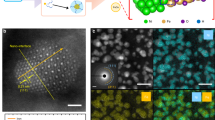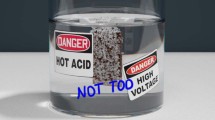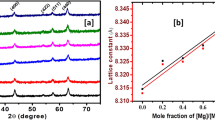Abstract
Industrially profitable water splitting is one of the great challenges in the development of a viable and sustainable hydrogen economy. Alkaline electrolysers using Earth-abundant catalysts remain the most economically viable route to electrolytic hydrogen, but improved efficiency is desirable. Recently, electron spin polarization was described as a potential way to improve water-splitting catalysis. Here, we report the significant enhancement of alkaline water electrolysis when a moderate magnetic field (≤450 mT) is applied to the anode. Current density increments above 100% (over 100 mA cm−2) were found for highly magnetic electrocatalysts, such as the mixed oxide NiZnFe4Ox. Magnetic enhancement works even for decorated Ni–foam electrodes with very high current densities, improving their intrinsic activity by about 40% to reach over 1 A cm−2 at low overpotentials. Thanks to its simplicity, our discovery opens opportunities for implementing magnetic enhancement in water splitting.
This is a preview of subscription content, access via your institution
Access options
Access Nature and 54 other Nature Portfolio journals
Get Nature+, our best-value online-access subscription
$29.99 / 30 days
cancel any time
Subscribe to this journal
Receive 12 digital issues and online access to articles
$119.00 per year
only $9.92 per issue
Buy this article
- Purchase on Springer Link
- Instant access to full article PDF
Prices may be subject to local taxes which are calculated during checkout




Similar content being viewed by others
Data availability
All experimental data generated or analysed during this study are included in this published article and its Supplementary Information files.
References
Zhang, B. et al. Homogeneously dispersed multimetal oxygen-evolving catalysts. Science 352, 333–337 (2016).
Xu, Y.-F. et al. In situ formation of zinc ferrite modified Al-doped ZnO nanowire arrays for solar water splitting. J. Mater. Chem. A 4, 5124–5129 (2016).
Cady, C. W. et al. Tuning the electrocatalytic water oxidation properties of AB2O4 spinel nanocrystals: A (Li, Mg, Zn) and B (Mn, Co) site variants of LiMn2O4. ACS Catal. 5, 3403–3410 (2015).
McKone, J. R., Lewis, N. S. & Gray, H. B. Will solar-driven water-splitting devices see the light of day? Chem. Mater. 26, 407–414 (2014).
Schmidt, O., Gambhir, A., Staffell, I., Nelson, J. & Few, S. Future cost and performance of water electrolysis: an expert elicitation study. Int. J. Hydrogen Energy 42, 30470–30492 (2017).
Carmo, M., Fritz, D. L., Mergel, J. & Stolten, D. A comprehensive review on PEM water electrolysis. Int. J. Hydrogen Energy 38, 4901–4934 (2013).
Yuan, W., Zhao, M., Yuan, J. & Li, C. M. Ni foam supported three-dimensional vertically aligned and networked layered CoO nanosheet/graphene hybrid array as a high-performance oxygen evolution electrode. J. Power Sources 319, 159–167 (2016).
Jia, J. et al. Solar water splitting by photovoltaic-electrolysis with a solar-to-hydrogen efficiency over 30%. Nat. Commun. 7, 13237 (2016).
Song, F. et al. Transition metal oxides as electrocatalysts for the oxygen evolution reaction in alkaline solutions: an application-inspired renaissance. J. Am. Chem. Soc. 140, 7748–7759 (2018).
Guo, C. X. & Li, C. M. Room temperature-formed iron-doped nickel hydroxide on nickel foam as a 3D electrode for low polarized and high-current-density oxygen evolution. Chem. Commun. 54, 3262–3265 (2018).
Trotochaud, L., Young, S. L., Ranney, J. K. & Boettcher, S. W. Nickel–iron oxyhydroxide oxygen-evolution electrocatalysts: the role of intentional and incidental iron incorporation. J. Am. Chem. Soc. 136, 6744–6753 (2014).
Zeng, K. & Zhang, D. Recent progress in alkaline water electrolysis for hydrogen production and applications. Prog. Energy Combust. Sci. 36, 307–326 (2010).
McCrory, C. C. L., Jung, S., Peters, J. C. & Jaramillo, T. F. Benchmarking heterogeneous electrocatalysts for the oxygen evolution reaction. J. Am. Chem. Soc. 4, 16977–16987 (2013).
Gracia, J. Spin dependent interactions catalyse the oxygen electrochemistry. Phys. Chem. Chem. Phys. 19, 20451–20456 (2017).
Gracia, J., Sharpe, R. & Munarriz, J. Principles determining the activity of magnetic oxides for electron transfer reactions. J. Catal. 361, 331–338 (2018).
Mtangi, W., Kiran, V., Fontanesi, C. & Naaman, R. Role of the electron spin polarization in water splitting. J. Phys. Chem. Lett. 6, 4916–4922 (2015).
Mtangi, W. et al. Control of electrons’ spin eliminates hydrogen peroxide formation during water splitting. J. Am. Chem. Soc. 139, 2794–2798 (2017).
Zhang, W., Banerjee-Ghosh, K., Tassanari, F. & Naaman, R. Enhanced electrochemical water splitting with chiral molecule-coated Fe3O4 nanoparticles. ACS Energy Lett. 3, 2308–2313 (2018).
Chretien, S. & Metiu, H. O2 evolution on a clean partially reduced rutile TiO2 (110) surface and on the same surface precovered with Au1 and Au2: the importance of spin conservation. J. Chem. Phys. 129, 074705 (2008).
Torum, E., Fang, C. M., de Wijs, G. A. & de Groot, R. A. Role of magnetism in catalysis: RuO2 (110) surface. J. Phys. Chem. C 117, 6353–6357 (2013).
Jiao, J., Sharpe, R., Lim, T., Niemantsverdriett, J. W. H. & Gracia, J. Photosystem II acts as a spin-controlled electron gate during oxygen formation and evolution. J. Am. Chem. Soc. 139, 16604–16608 (2017).
Elias, L. & Hegde, C. Effect of magnetic field on HER of water electrolysis on NiÐW alloy. Electrocatalysis 8, 375–382 (2017).
Zheng, Z. et al. Magnetic field-enhanced 4-electron pathway for well-aligned Co3O4/electrospun carbon nanofibers in the oxygen reduction reaction. Chem. Sus. Chem. 11, 580–588 (2018).
Katz, E., Lioubashevski, O. & Willner, I. Magnetic field effects on bioelectrocatalytic reactions of surface-confined enzyme systems: enhanced performance of biofuel cells. J. Am. Chem. Soc. 127, 3979–3988 (2005).
Monzon, L. M. A., Rode, K., Venkatesan, M. & Coey, J. Electrosynthesis of iron, cobalt, and zinc microcrystals and magnetic enhancement of the oxygen reduction reaction. Chem. Mater. 24, 3878–3885 (2012).
Niether, C. et al. Improved water electrolysis using magnetic heating of FeC–Ni core–shell nanoparticles. Nat. Energy 3, 476–483 (2018).
Giordano, L. et al. pH dependence of OER activity of oxides: current and future perspectives. Catal. Today 262, 2–10 (2016).
McCrory, C. C. L. et al. Benchmarking hydrogen evolving reaction and oxygen evolving reaction electrocatalysts for solar water splitting devices. J. Am. Chem. Soc. 137, 4347–4357 (2015).
Trotochaud, L., Ranney, J. K., Williams, K. N. & Boettcher, S. W. Solution-cast metal oxide thin film electrocatalysts for oxygen evolution. J. Am. Chem. Soc. 134, 17253–17261 (2012).
Gerken, J. B., Shaner, S. E., Massé, R. C., Porubsky, N. J. & Stahl, S. S. A survey of diverse Earth abundant oxygen evolution electrocatalysts showing enhanced activity from Ni–Fe oxides containing a third metal. Energy Environ. Sci. 7, 2376–2382 (2014).
Smith, R. D. L. et al. Photochemical route for accessing amorphous metal oxide materials for water oxidation catalysis. Science 340, 60–63 (2013).
Seitz, L. C. et al. A highly active and stable IrOx/SrIrO3 catalyst for the oxygen evolution reaction. Science 353, 1011–1014 (2016).
Liu, G., Wang, K., Gao, X., He, D. & Li, J. Fabrication of mesoporous NiFe2O4 nanorods as efficient oxygen evolution catalyst for water splitting. Electrochim. Acta 211, 871–878 (2016).
Liu, G., Gao, X., Wang, K., He, D. & Li, J. Uniformly mesoporous NiO/NiFe2O4 biphasic nanorods as efficient oxygen evolving catalyst for water splitting. Int. J. Hydrogen Energy 41, 17976–17986 (2016).
Dez-Garca, M. I., Lana-Villarreal, T. & Gómez, R. Study of copper ferrite as a novel photocathode for water reduction: improving its photoactivity by electrochemical pretreatment. ChemSusChem 9, 1504–1512 (2016).
Ng, J. W. D. et al. Gold-supported cerium-doped NiOx catalysts for water oxidation. Nat. Energy 1, 16053 (2016).
Islam, M. U. et al. Electrical behaviour of fine particle, co-precipitation prepared Ni–Zn ferrites. Solid State Commun. 130, 353–356 (2004).
Wang, X. et al. A novel NiZn ferrite integrated magnetic solenoid inductor with a high quality factor at 0.7–6 GHz. AIP Adv. 7, 056606 (2017).
He, Q. et al. Electrically controllable spontaneous magnetism in nanoscale mixed phase multiferroics. Nat. Commun. 2, 225 (2011).
Su, Y.-Z. et al. One dimensionally spinel NiCo2O4 nanowire arrays: facile synthesis, water oxidation, and magnetic properties. Electrochim. Acta 174, 1216–1224 (2015).
Mayrhofer, K. J. J., Wiberg, G. K. H. & Arenz, M. Impact of glass corrosion on the electrocatalysis on Pt electrodes in alkaline electrolyte. J. Electrochem. Soc. 155, P1–P5 (2008).
Rodriguez, P., Tichelaar, F. D., Koper, M. T. M. & Yanson, A. I. Cathodic corrosion as a facile and effective method to prepare clean metal alloy nanoparticles. J. Am. Chem. Soc. 133, 17626–17629 (2011).
Chen, R. et al. Use of platinum as the counter electrode to study the activity of nonprecious metal catalysts for the hydrogen evolution reaction. ACS Energy Lett. 2, 1070–1075 (2017).
Dong, G. et al. In situ formation of highly active NiFe based oxygen-evolving electrocatalysts via simple reactive dip-coating. J. Mater. Chem. A 5, 11009–11015 (2017).
Zhou, H. et al. Highly active catalyst derived from a 3D foam of Fe(PO3)2/Ni2P for extremely efficient water oxidation. Proc. Natl Acad. Sci. USA 114, 5607–5611 (2017).
Chen, J. Y. C., Miller, J. T., Gerken, J. B. & Stahl, S. S. Inverse spinel NiFeAlO4 as a highly active oxygen evolution electrocatalyst: promotion of activity by a redox-inert metal ion. Energy Environ. Sci. 7, 1382–1386 (2014).
Carmo, M., Doubek, G., Sekol, R. C., Linardi, M. & Taylor, A. D. Development and electrochemical studies of membrane electrode assemblies for polymer electrolyte alkaline fuel cells using FAA membrane and ionomer. J. Power Sources 230, 169–175 (2013).
Ellms, J. W. & Hauser, S. J. Ortho-tolidine as a reagent for the colorimetric estimation of small quantities of free chlorine. J. Ind. Eng. Chem. 5, 915–917 (1913).
Acknowledgements
This work was funded by: the European Union’s Horizon 2020 research and innovation programme under grant agreement CREATE number 721065; FEDER/Ministerio de Ciencia, Innovación y Universidades – Agencia Estatal de Investigación/RTI2018-095618-B-I0; and the Generalitat de Catalunya (2017-SGR-1406 and the CERCA Programme). The authors also acknowledge BSC-RES for computational resources.
Author information
Authors and Affiliations
Contributions
J.R.G.-M. and N.L. proposed the concept. F.A.G.-P. and J.R.G.-M. designed the experiments. M.B.-A. and F.A.G.-P. performed the synthesis, processing and electrochemical experiments. D.N.-C. performed the magnetic measurements and analyses. N.L. performed the computational studies. All authors wrote the manuscript.
Corresponding author
Ethics declarations
Competing interests
The authors declare no competing interests.
Additional information
Publisher’s note: Springer Nature remains neutral with regard to jurisdictional claims in published maps and institutional affiliations.
Supplementary information
Supplementary Information
Supplementary methods, discussion, Figs. 1–18, Tables 1 and 2, and references
Supplementary Video 1
Water electrolysis enhancement on approaching a permanent magnet to a Ni–foam/NiZnFe4Ox-decorated anode working at a constant voltage of 1.67 V versus RHE in a single cell.
Supplementary Video 2
Water electrolysis enhancement on approaching a permanent magnet to a Ni–foam/NiZnFeOx-decorated anode working at 100 mA cm−2 in a single cell.
Supplementary Video 3
Anodic current enhancement on approaching a permanent magnet to a Ni–foam/NiZnFeOx-decorated anode working at 10 mA cm−2 in a H cell.
Rights and permissions
About this article
Cite this article
Garcés-Pineda, F.A., Blasco-Ahicart, M., Nieto-Castro, D. et al. Direct magnetic enhancement of electrocatalytic water oxidation in alkaline media. Nat Energy 4, 519–525 (2019). https://doi.org/10.1038/s41560-019-0404-4
Received:
Accepted:
Published:
Issue Date:
DOI: https://doi.org/10.1038/s41560-019-0404-4
This article is cited by
-
Enhancement of electrocatalysis through magnetic field effects on mass transport
Nature Communications (2024)
-
Dual-site segmentally synergistic catalysis mechanism: boosting CoFeSx nanocluster for sustainable water oxidation
Nature Communications (2024)
-
Enhanced hydrogen evolution reaction in FePt film with remanence due to decrease in domain walls
Rare Metals (2024)
-
Optimizing spin arrangement by permeability modulation of high-entropy alloys to promote O-O formation for efficient water oxidation
Science China Materials (2024)
-
Regulating electrochemical performances of lithium battery by external physical field
Rare Metals (2024)



